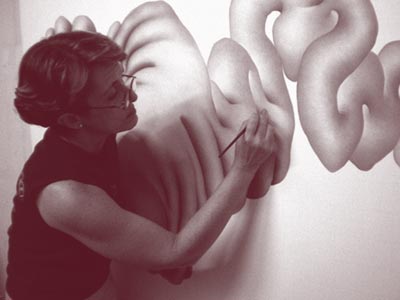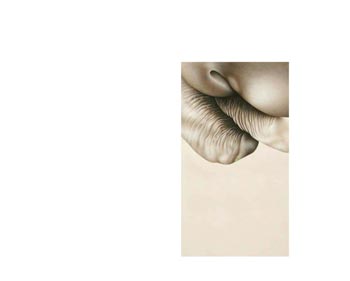Flesh is the laconic, intense title of the latest collective exhibit Sara Hooper has been involved in.1 Even though the word carnein Spanish seems to underscore the animal character of the matter and lets in a somewhat bizarre, un-poetic term, in English –a language Sara is familiar with– the human flesh denotes physical and spiritual passion, “that red cloud whose lightning bolt is the soul,” as Marguerite Yourcenar2would put it. So it is flesh rather than meat what Hooper’s painting exhibition is all about. It’s this refined flesh curdled in solitude and abandonment, the phlegmatic passion –if you want to put it that way– the tense and yet relaxed flesh.
 Of Anglo-Argentine origin, Sara Hooper settled down in Asuncion in the late 1970s when Paraguay was a country barely known for its heat, its oranges and the strong-hand dictatorship of Alfredo Stroessner, a man who’d been in power for over twenty years.
Of Anglo-Argentine origin, Sara Hooper settled down in Asuncion in the late 1970s when Paraguay was a country barely known for its heat, its oranges and the strong-hand dictatorship of Alfredo Stroessner, a man who’d been in power for over twenty years.
The daughter of a Sunday painter –her father was an deontologist from whom she inherited a melancholic palette– Hooper lived her teens shuttling between Buenos Aires and southern Patagonia, far down to the south of Argentina where she used to spend long periods of time in the family’s countryside home. It was there where she grew to love horses and the expanded horizons that were later on splayed in her paintings. Her start in the realm of arts were closely tied up to the figure of that animal that to her continues to be the representation of a lost world. With the sale of family lands, those pleasant times were left behind, far behind as the large flatlands she used to scour on horseback, as far behind as that mountain that so out of her reach now, though she always knew it belonged to her.
Sara Hooper rolled out her first exhibition at the now gone Sepia Gallery in Asuncion, back in 1983. In front of her current work, initiated in 2002 and in which is impossible to tell the human and the animal apart, the artist recalls those days. “I started drawing horses, hair by hair. I used to paint the eyes with their different layers, the snouts that seem to be made of velvet, a nearly erotic surface.” Despite her knowing the animal’s anatomy by heart, as well as its physiology and mind frames, Hooper –a devoted equestrian practitioner as the good Briton she is- never managed to portray horses in their full-length scope. “I used to draw horse heads more than anything else, highlighting the lips, the nostrils, the manes. I never drew a background; there never was a backdrop. The heads were floating freely on the white sheet of paper; then they were well cut out, well centered.”
Today, Ticio Escobar says, “her figures feed on the memory of the animal’s body to break free from the circle of mimesis and gallop down new pathways of meaningfulness.”3 We access them through a “window” hemmed in by the immaculate white. This space of silence is for Hooper as meaningful as the figures she draws. It’s an empty context, a mighty nothingness that invites to peek into it, a sort of étant doné that triggers body-mingling eroticism.4
José Luis Brea associated Hooper’s work to the research studies of Lynn Margulis, the American geneticist who shared her life with Carl Sagan and wrote Mystery Dance: On the Evolution of Human Sexuality.During a brief trip to Asuncion, Brea suggested Hooper the reading of this essay that broaches human evolution based on a radical concept: the regressive striptease that eventually lets in the early forms of life.
 By meeting Margulis, Hooper managed to voice her own proceedings: “The layers of my paintings recreate the layers of human evolution. That explains the impossibility of the rush. It needs time to be borne by accumulation, by the sedimentation of forms and colors. Accidents and failed attempts are also important because they generate new effects that otherwise would have never been born.”
By meeting Margulis, Hooper managed to voice her own proceedings: “The layers of my paintings recreate the layers of human evolution. That explains the impossibility of the rush. It needs time to be borne by accumulation, by the sedimentation of forms and colors. Accidents and failed attempts are also important because they generate new effects that otherwise would have never been born.”
Each painted surface clusters long processes of mutation in the physical and psychic fields, from microorganisms all the way to the human brain: “As I paint I imagine the animal character of our attitudes, I realize primitive and intuitive warning stages; I feel the reptile as it sloughs off its skin, the addition of all evolutionary stages in the beings. It was a very inspiring book.”
Sara Hooper defines her technique as “a result of contradictory anxieties and unleashed patience.” She boasts proverbial calmness when she paints, patience that leads her to achieving countless shades within a single range. She manages to get exquisite monochromes, a color of “flesh” that expresses both the lividness of pleasure and demise.
In these fragmented organic formations there’s abundance of dispersion, concentration and depth of field. “In the past, my painting was frontal. Today, there’s both roominess and distance. I’ve always liked the fold, that dangling flesh: wrinkles, small cavities, nooks and crannies that conceal history.” Flimsy and sensual, these folds and counter-folds whirl around like ghostly entities that take on the smooth or tortured shapes of societies and individuals, including those of nature itself.
Holder of visceral eroticism that some have even labeled as obscene, Hooper’s work has been successfully exhibited in Buenos Aires (where she shared both the hall and the prizes with Jacques Bedel and Clorindo Testa),5 in Murcia (Fernando Guerao Gallery), in Washington (artDC) and Zurich (Art International). In Paraguay, she remains quasi confidential,6 like a rara avis, nearly hidden in her own maze.
1Flesh, CAV/Museo del Barro, Asuncion, Jun.-Sept. 2010.
2Timely quotation made by Lia Colombino in the forewords to the abovementioned exhibit.
3Ticio Escobar, Hall text, Galería Fábrica, Asuncion, 2004.
4Currently Sara Hooper is working on a new series, as she’s ruling out this resource.
5Aerolineas Argentinas Iberian American Painting Prize Exhibition, Borges Cultural Center, Buenos Aires, 2004.
6In Asuncion she exhibited at Galería Fábrica, 2004 and Centro Cultural de la Ciudad, 2005.
Related Publications

How Harumi Yamaguchi invented the modern woman in Japan
March 16, 2022












